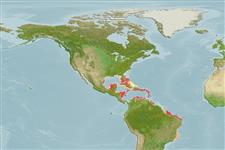Common names from other countries
Classification / Names / Names
Nomi Comuni | Sinonimi | Catalog of Fishes (gen., sp.) | ITIS | CoL | WoRMS
Environment: milieu / climate zone / depth range / distribution range
Ecologia
; salmastro; distribuzione batimetrica 1 - 25 m (Ref. 108813). Tropical; 25°C - 33°C (Ref. 86836)
Western Central Atlantic.
Length at first maturity / Size / Peso / Age
Maturity: Lm ? range ? - ? cm Max length : 4.0 cm OT maschio/sesso non determinato; (Ref. 415)
Mounds or cushions: 2 - 4 cm thick, pinkish to violet externally, lighter internally. Smooth, punctuate surface, sometimes with small tubercles: 0.1 - 0.2 cm high; 0.1 cm wide. Compressible, but soft. Oscules scattered: 0.5 - 1 cm wide (Ref. 415). Grows massive or in rounded mounds (Ref. 86785).
Body thickness: 4 cm (Ref. 415). Found in mangroves (Ref. 86836).
Life cycle and mating behavior
Maturità | Riproduzione | Deposizione | Uova | Fecundity | Larve
Members of the class Demospongiae are hermaphroditic. Life cycle: The zygote develops into parenchymella larva (free-swimming) before settling down on a substrate where it grows into a young sponge.
Collin, R., M.C. Díaz, J. Norenburg, R.M. Rocha, J.A. Sánchez, M. Schulze, A. Schwartz and A. Valdés. 2005. (Ref. 415)
IUCN Red List Status (Ref. 130435)
CITES status (Ref. 108899)
Not Evaluated
Not Evaluated
Threat to humans
Harmless
Human uses
| FishSource |
Strumenti
Fonti Internet
Estimates based on models
Preferred temperature
(Ref.
115969): 25.3 - 28.2, mean 27.2 (based on 495 cells).
Vulnerability
Low vulnerability (10 of 100).
Price category
Unknown.
